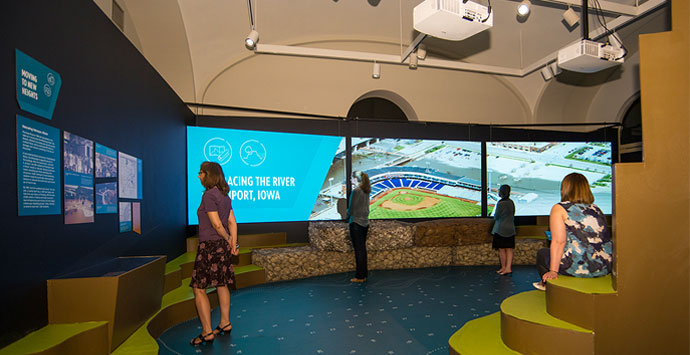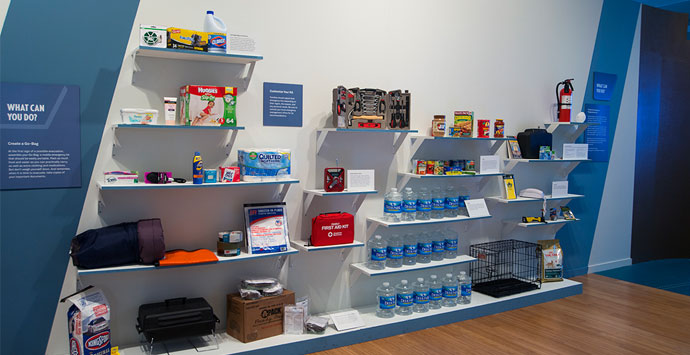Designing for Disaster
Designing for Disaster — an exhibition that opened this past May — is, by far, the most challenging exhibition I have organized in my 18 years at the National Building Museum. The exhibition’s premise: That we can prevent, reduce the impact of, and better prepare for natural disasters before they occur is not controversial; it is empowering. But, it is predicated on the fact that we have miscalculated, unintentionally contributed to, or simply ignored certain risks in the past — and will continue to do so.
The vision of the exhibition’s New York based-designers, C&G Partners, was unwavering: Each of the primary galleries (earth, air, fire, and water) should impart a sense of peril to help keep the tension and the stakes high. The exposed stud walls in the fire gallery, for example, are scorched black, and when the exhibition debuted, you could detect a faint, burnt odor.
So how did we keep the focus on the positive? By presenting dozens of successful, domestic case studies — new and old — that show how individuals, nonprofits, private entities, communities, and federal agencies are addressing threats from all types of natural hazards (i.e., earthquakes, tornadoes, hurricanes, wildfires, flooding, storm surge, and sea level rise). And just as the design of each gallery evokes a specific hazard, it also points the way to various mitigation strategies and solutions. The water gallery was particularly tricky — but one of the inspirations for its design was AECOM’s work in Blackpool, United Kingdom, where a reimagined promenade was integrated with coastal defenses. The Blackpool project celebrates the water’s edge and Designing for Disaster also suggests this approach.
Designed to break the cycle of disaster, rather than repeat it, hazard mitigation can not only help save lives, protect property, and reduce losses, it can also help individuals, communities, and regions recover more quickly after a disaster. Mitigation, however, is more demanding than simply rebuilding, it requires rethinking. And after a disaster, it sometimes runs counter to a community’s desire to quickly return to normal.
Not surprisingly, cities that have suffered repeated losses have led the way when it comes to adopting new strategies. For example, Florida’s Miami-Dade County was the first to require windborne debris impact protection; San Francisco is the only city to mandate seismic retrofits for soft or “weak” story structures; Tulsa, Oklahoma, adopted comprehensive floodplain and stormwater management; and Davenport, Iowa, has more recently created multi-functional landscapes designed to slow and absorb floodwaters. I found no better advocates for mitigation than the individuals and communities that have suffered through a disaster — only they know how truly devastating these events can be, especially emotionally and economically. And they are eager to share their hard fought victories.
The exhibition’s case studies are punctuated by a series of expert spotlight videos, featuring five outstanding professionals directly engaged in mitigation: Structural Engineer Dr. H. Kit Miyamoto; Meteorologist Dr. Richard Knabb; Research Physical Scientist Jack D. Cohen; Architect David Waggonner; and Landscape Architect Kate Orff. Hearing from professionals is appealing to our general audiences as well as professionals in the field — and can be especially eye-opening for young adults. Although not an explicit goal of the exhibition, or the museum, the exhibition team did consciously seek to highlight different career paths and opportunities in the growing fields of emergency management and mitigation.
To help educate and keep visitors engaged in this challenging subject, we developed a series of iPad-based quizzes and included some fun, hands-on interactives — the most popular is modeled on the International Hurricane Research Center’s Wall of Wind at Florida International University (as pictured in the main image).
In some ways, however, I think the most powerful and effective tool to drive home both the seriousness of the subject, and the power of individual action, is the exploded emergency preparedness kit, and “go bag” we showcase in the concluding gallery.
Having emergency supplies readily available is one of the easiest, and most meaningful ways you can reduce the impact of a natural disaster on you and your family — especially if emergency responders are not able to reach you right away. Once you take this simple step, and actively invest in reducing your risk, you are far more likely to take further mitigating actions.
Chrysanthe B. Broikos is an architectural historian and curator at the National Building Museum in Washington, D.C. She also teaches a curatorial practice course for Georgetown University’s graduate Art and Museum Studies program. Designing for Disaster is on view at the museum through August 2, 2015.
Twitter: @BuildingMuseum
Facebook: National Building Museum
Tumblr: designing4disaster
Flickr: National Building Museum










